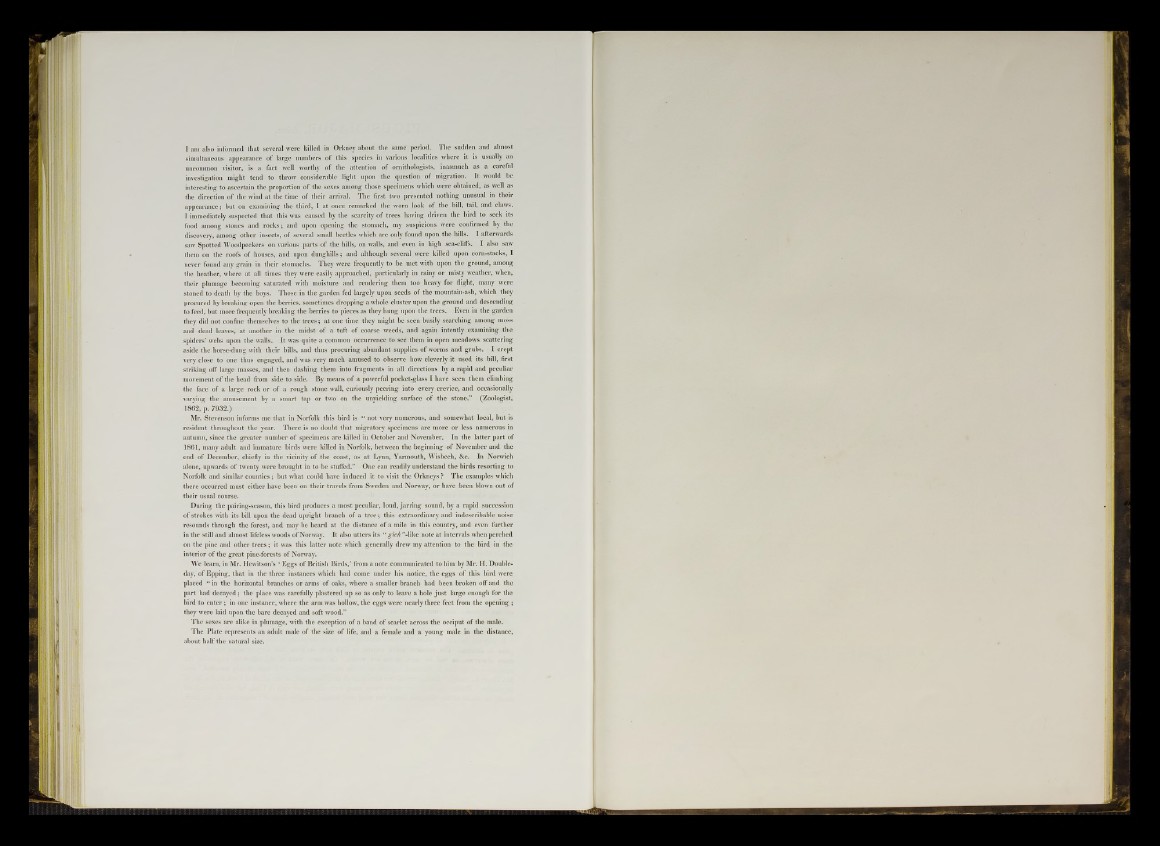
1 am also informed that several were killed in Orkney about the same period. The sudden and almost
simultaneous appearance of large numbers of this species in various localities where it is usually an
uncommon visitor, is a fact well worthy of the attention of ornithologists, inasmuch as a careful ! investigation might tend to throw considerable light upon the question of migration. It would be
interesting to ascertain the proportion of the sexes among those specimens which were obtained, as well as
the direction of the wind at the time of their arrival. The first two presented nothing unusual in their
appearance; but on examining the third, I at once remarked the worn look of the bill, tail, and claws.
I immediately suspected that this was caused by the scarcity of trees having driven the bird to seek its
food among stones and rocks; and upon opening the stomach, my suspicions were confirmed by the
discovery, among other insects, of several small beetles which are only found upon the hills. I afterwards
saw Spotted Woodpeckers on various parts of the hills, on walls, and even in high sea-cliffs. I also saw
them on the roofs of houses, and upon dunghills; and although several were killed upon corn-stacks, I
never found any grain in their stomachs. They were frequently to be met with upon the ground, among
the heather, where at all times they were easily approached, particularly in rainy or misty weather, when,
their plumage becoming saturated with moisture and rendering them too heavy for flight, many were
stoned to death by the boys. Those in the garden fed largely upon seeds of the mountain-ash, which they
procured by breaking open the berries, sometimes dropping a whole cluster upon the ground and descending
to feed, but more frequently breaking the berries to pieces as they hung upon the trees. Even in the garden
they did not confine themselves to the trees; at one time they might be seen busily searching among moss
and dead leaves, at auother in the midst of a tuft of coarse weeds, and again intently examining the
spiders’ webs upon the walls. It was quite a common occurrence to see them in open meadows scattering
aside the horse-dung with their bills, and thus procuring abundant supplies of worms and grubs. I crept
very close to one thus engaged, and was very much amused to observe how cleverly it used its bill, first
striking off large masses, and then dashing them into fragments in all directions by a rapid and peculiar
movement of the head from side to side. By means of a powerful pocket-glass I have seen them climbing
the face of a large rock or of a rough stone wall, curiously peering into every crevice, and occasionally
varying the amusement by a smart tap or two on the unyielding surface of the stone.” (Zoologist,
1862, p . 7932.)
Mr. Stevenson informs me that in Norfolk this bird is “ not very numerous, and somewhat local, but is
resident throughout the year. There is no doubt that migratory specimens are more or less numerous in
autumn, since the greater number of specimens are killed in October and November. In the latter part of
1861, many adult and immature birds were killed in Norfolk, between the beginning of November and the
end of December, chiefly in the vicinity of the coast, as at Lynn, Yarmouth, Wisbech, &c. In Norwich
alone, upwards of twenty were brought in to be stuffed.” One can readily understand the birds resorting to
Norfolk and similar counties; but what could have induced it to visit the Orkneys ? The examples which
there occurred must either have been on their travels from Sweden and Norway, or have been blown out of
their usual course.
During the pairing-season, this bird produces a most peculiar, loud, jarring sound, by a rapid succession
of strokes with its bill upon the dead upright branch of a tree; this extraordinary and indescribable noise
resounds through the forest, and may be heard at the distance of a mile in this country, and even further
in the still and almost lifeless woods of Norway. It also utters its “ gich ’’-like note at intervals when perched
on the pine and other trees; it was this latter note which generally drew my attention to the bird in the
interior of the great piue-forests of Norway.
We learn, in Mr. Hewitson’s * Eggs of British Birds,’ from a note communicated to him by Mr. H. Doubleday,
of Epping, that in the three instances which had come under his notice, the eggs of this bird were
placed “ in the horizontal branches or arms of oaks, where a smaller branch had been broken off and the
part had decayed; the place was carefully plastered up so as only to leave a hole just large enough for the
bird to enter; in one instance, where the arm was hollow, the eggs were nearly three feet from the opening ;
they were laid upon the bare decayed and soft wood.”
The sexes are alike in plumage, with the exception of a band of scarlet across the occiput of the male.
The Plate represents an adult male of the size of life, and a female and a young male in the distance,
about half the natural size.